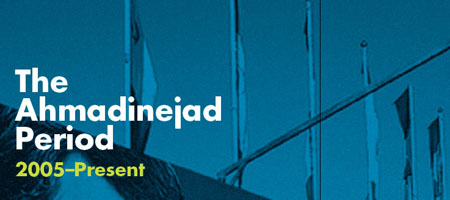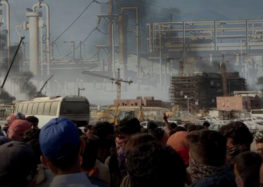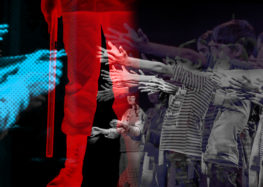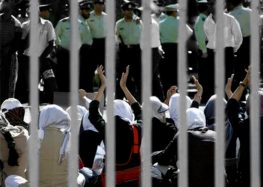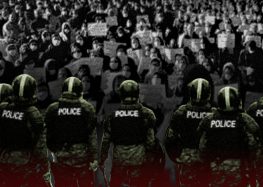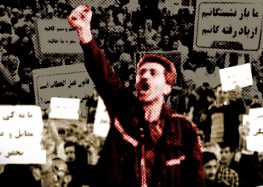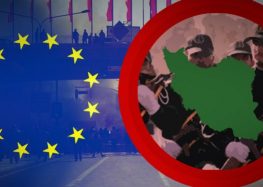The Ahmadinejad Period (2005–Present)
A Growing Crisis: The Impact of Sanctions and Regime Policies on Iranians’ Economic and Social Rights
The Ahmadinejad Period (2005-Present)
Even before the imposition of the 2012 sanctions, however, the sanctions regime against Iran had already become less targeted and more multilateral, comprehensive, and costly. The enormous quantities of petro-dollars flowing directly into the coffers of the Iranian government because of rising oil prices, however, provided the regime with a cushion that enabled it to tolerate both the additional costs associated with sanctions and the severe mismanagement of the Iranian economy. The US’s decision to tighten sanctions on Iran was prompted by the Ahmadinejad administration’s decision to restart Iran’s enrichment program in 2005 and his bellicose utterances about Israel. Thereafter, IAEA’s referral of the Iranian nuclear dossier to the United Nation’s Security Council (UNSC), Iran’s refusal to heed the Council’s demand that it halt its enrichment-related and processing activities, and the Council’s passage of several resolutions against Iran led to the emergence of a pattern.
This pattern entailed the US adopting much tougher sanctions on its own to supplement the Security Council sanctions, and prodding its allies to further increase the economic isolation of Iran and adopt more stringent sanctions of their own. For the most part, these efforts paid off, especially with the EU, Canada, Australia, Japan, South Korea, and the UAE—though not with Russia, China, and India. These more stringent and multilateral sanctions increased the costs that sanctions were inflicting on Iran, though they did not as yet affect Iran’s revenue streams.
A brief scrutiny of the nature and rising costs of the US, UN, and EU sanctions on Iran between 2005 and 2011, along with greater details of Ahmadinejad’s far more damaging domestic economic policies will now follow.
Iran’s nuclear dossier was referred to the UNSC in February 2006, when the report of then–Director General of the UN’s International Atomic Energy Agency (IAEA) Mohammad El-Baradei found Iran to be in non-compliance with its safeguard operations and raised concerns about the potential military dimensions of Iran’s nuclear program. In March 2006, the president of the Security Council called upon Iran to suspend its enrichment activities. Iran’s refusal to comply with this demand resulted in the adoption of Resolution 1696 by the Security Council in July 2006. In addition to calling upon Iran to suspend its enrichment and reprocessing activities, the resolution urged the country to reconsider the construction of a heavy water research reactor. It also granted Iran a month to desist from its objectionable behavior or otherwise face the possibility of economic and diplomatic sanctions.[49]
Having disregarded the demands of the Security Council, Iran was for the first time confronted with a UNSC sanctions resolution in December 2006. Resolution 1737 blocked “the import or export of sensitive nuclear material and equipment and froze the financial assets of persons or entities supporting its proliferation sensitive nuclear activities or the development nuclear-weapon delivery systems.”[50] Additionally, the resolution called upon Iran to suspend all of its enrichment and reprocessing activities. Iran’s unwillingness to abide by the Council’s demands prompted the UNSC to adopt another resolution against the Islamic Republic in March 2007: apart from banning Iran’s arms exports, Resolution 1747 placed travel restrictions on and froze the assets of more individuals suspected of being involved in the country’s proliferation activities.[51]
With the Islamic Republic’s continued defiance of the UNSC, the Council adopted two additional resolutions against Iran, Resolution 1803, passed in March 2008, and Resolution 1929, adopted in June 2010. Resolution 1803 expanded prohibitions of exports to Iran to include not just nuclear-specific material but also dual-use technology. It also further expanded the list of proscribed individuals and entities involved in Iran’s nuclear and missile programs. Significantly, the resolution provided for an expansion of monitoring of Iranian banks suspected of being involved in financing proliferation activities, and inspection of “cargo to and from Iran of aircraft and vessels owned or operated by Iran Air Cargo and Islamic Republic of Iran Shipping Line, provided ‘reasonable grounds’ existed to believe that the aircraft or vessel was transporting prohibited goods.”[52] Resolution 1929, meanwhile, once again expanded the number of individuals and entities involved in Iran’s nuclear program that are subjected to sanctions. It also banned the export of heavy and combat conventional weapons to Iran and prohibited the country from engaging in “any activities related to ballistic missiles. The resolution also call[ed] upon states to prevent the provision of financial services or insurance to [Iran] if there [were] reasonable grounds to believe that such services could contribute to Iran’s nuclear or missile programs.”[53] By departing from precedent and granting states the right to monitor Iran’s shipping, financial, and banking activities, both resolutions provided the US and its partners with the basis for imposing far more stringent prohibitions against Iran’s financial and shipping sectors as well as the provision of banking, finance, insurance, and shipping services to the Islamic Republic—thereby increasing Iran’s transaction costs.
Even before the adoption of these sanctions, however, the US had already started to receive greater cooperation from its allies and partners in imposing additional costs on Tehran. In 2005, President George W. Bush issued Executive Order 13382, “to freeze the assets of proliferators of WMD and their supporters and isolate them financially. Eight Iranian entities and external organizations believed to be supporting Iranian WMD programs were designated under the executive order and sanctioned.”[54] In 2006, the US adopted the Iran Freedom Support Act, offering financial assistance to Iranian dissidents inside and outside the Islamic Republic and to media outlets seeking to bring about the peaceful transformation and democratization of the Iranian regime.[55] Also in 2006, the US passed the Iran, North Korea, and Syria Nonproliferation Act, providing “for penalties on entities and individuals for the transfer to or acquisition from since January 1, 1999 . . . of equipment and technology controlled under multilateral control lists.”[56] Thereafter, in 2007, the US singled out the Iranian Revolutionary Guard Corps, which had come to dominate an increasing proportion of the Iranian economy, as a proliferator of weapons of mass destruction.[57]
Most importantly in terms of inflicting increasing costs on the Iranian economy, “in 2007, as questions about Iran’s nuclear program grew, the Treasury Department under George W. Bush deployed a new strategy: blacklisting Iranian banks one by one, forcing foreign banks to decide whether to do business with Iran or the vastly larger US economy. . . . Treasury officials traveled the globe, carrying reams of financial intelligence. They spoke ‘the language of risks’ to bankers and governments, [Daniel] Glaser [Assistant Secretary of Treasury for Terrorist Financing] said, seeking to persuade them to make Iran a financial pariah.”[58] This “strategy . . . prove[d] unexpectedly effective in isolating Iran and increasing the costs of doing business for Iranian entities. The country’s former nuclear negotiator, Hassan Rowhani . . . estimated [in December 2008] that these new financial restrictions [had] added costs ranging from 10 to 30 percent to the cost of imports,”[59] which were subsequently passed on to Iranian consumers and industries.
Starting in 2007, the international isolation and subsequent costs imposed upon the Islamic Republic increased further as the EU began to go beyond UN sanctions and impose additional sanctions of its own. On the basis of Common Positions 2007/140 and 2007/246, the EU prohibited individuals associated with Iran’s nuclear program from traveling in the EU, banned all nuclear and missile trade with and all conventional weapons export to Iran, froze the accounts of all individuals and entities associated with Iran’s missile and nuclear programs, and prohibited the extension of grants, financial assistance, and concessional loans to Iran.[60]
In 2008, the EU added more Iranian individuals and entities to the list of those who were to be prohibited from traveling in the EU and whose assets were to be frozen. Moreover, Common Position 2008/652 urged caution upon EU members in facilitating trade with Iran through financial support and requested that they carefully monitor the interactions of European financial institutions with suspicious Iranian banks.[61]
Iran’s transaction costs increased substantially in the summer of 2010 when, after the passage of UNSC Resolution 1929, both the US and the EU, as well as the “coalition of the willing” (Canada, Australia, Japan, South Korea, and Norway), supplemented the UN resolution by adopting more stringent sanctions of their own. Resolution 1929’s reference to “the potential connection between Iran’s revenues derived from its energy sector and the funding of Iran’s proliferation-sensitive nuclear activities”[62] prompted both the US Congress and the European Commission to act. Shortly thereafter, the passage of the Comprehensive Iran Sanctions Accountability and Divestment Act (CISADA) closed the loopholes of the Iran-Libya Sanctions Act and added a number of extraterritorial sanctions to it. The law “directs the president to impose sanctions on any person (meaning any individual, organization, or institution) that makes an investment of $20 million or more in Iran’s petroleum industry. Similarly, the legislation requires that the president sanction any person that provides Iran with goods, services, technology, or information with a fair market value of $1 million or more for the maintenance or expansion of Iran’s production of refined products. In addition, the [law] would apply US sanctions to any individual or organization that exports more than $1 million worth of gasoline [(at the time Iran was importing 40 percent of its refined petroleum)] to Iran, or provides $1 million worth of goods or services that could contribute to Iran’s ability to import gasoline.”[63] In the meantime, “a week after the UN vote, the EU announced its own sanctions: restrictions on banking, insurance, and shipping; visa bans and asset freezes of Islamic Revolutionary Guard; and measures to ban investment in the oil and gas sectors as well as transfers of related technology.”[64]
Although in the aggregate these measures substantially increased Iran’s transaction costs, which were passed on to Iranian citizens, the rise in the price of oil, as well as the ability of the central bank of Iran to take over the activities that had hitherto been conducted by Iran’s commercial banks, still allowed the Islamic Republic to tolerate and mitigate the impact of sanctions.
However, there can be no doubt that the preconditions for the continuing decline in purchasing power and standard of living presently afflicting the overwhelming majority of the Iranian population were set in motion by the economic, foreign, and nuclear policies enacted during Ahmadinejad’s presidency.[65] Moreover, at least during the first six-and-a-half years of his presidency, Ahmadinejad was able to carry out these policies with the backing of Iran’s Supreme Leader, Ayatollah Seyyed Ali Khamenei.
Paradoxically, when Ahmadinejad and those affiliated with him in the ruling establishment began to display greater flexibility in their willingness to resolve the nuclear issue (in order to bring about the lessening of sanctions and improve their prospects of holding on to the presidency after Ahmadinejad’s tenure in office ended in 2013), they were reined in by Iran’s Supreme Leader, who has the final say on all foreign and domestic policies.[66] Nevertheless, in addition to exacerbating the worst structural flaws in Iran’s political economy, the policies and postures adopted during the Ahmadinejad presidency[67] also contributed to the imposition of, and made the country much more vulnerable to, what has been variously referred to as the most far-reaching and punitive sanctions in history.[68]
Ironically, Ahmadinejad was elected to his first term in office in 2005 by campaigning on a platform that stressed the need to return the revolution to its roots through the promotion of policies designed to enhance social justice and bring about decent standards of living for all. Ahmadinejad argued that he had stood for office in order to return the revolution to its true path: improvement of the plight of the dispossessed and the underprivileged. Instead of promoting inclusive growth and social justice, he argued, the revolution had resulted in the maximization of wealth and power in the hands of the well connected few. He promised to combat poverty and bring about the eradication of entrenched inequality through the creation of gainful employment, promotion of transparency, obliteration of corruption, and expansion of equity.[69] His most famous campaign slogan touted the necessity of giving all Iranian citizens a stake in the country’s oil wealth by helping to put the nation’s oil earnings on their dining tables.[70]
In reality, the converse has happened. President Ahmadinejad has pursued the achievement of his populist objectives through ill-conceived, ad hoc fiscal and monetary policies. These policies have fueled galloping inflation and stagnation, raised the number of bankruptcies and layoffs, and produced unprecedented levels of unemployment, along with heightening disparities in wealth and income. They have also made the country more dependent on oil income and imports, while expanding and consolidating the control and ownership of the government and the security and coercive apparatus, especially the Iranian Revolutionary Guard Corps (IRGC), over the Iranian economy.[71] Indeed, in recent years, the IRGC has increased its hold over the service, manufacturing, and especially the commercial sectors of the economy, with its enterprises estimated to account for roughly 30 percent of the Iranian economy. As with the bonyads, it does not pay taxes.[72] Enjoying extensive access to the cheapest exchange rates, security and governmental organizations have been able to monopolize many industries. In the meantime, “Poverty—which by different estimates still afflicts some 9 to 15 million individuals, or about 13 to 20 percent of the population—has remained intact or even worsened. By a recent estimate, the Gini coefficient of income—a zero to one scale of a country’s income distribution—deteriorated in three years [2005-2008] from 0.43 to 0.58.”[73]
Against the advice of virtually all of the nation’s economists and seasoned managers, most of whom he sacked during the nascent period of his presidency, Ahmadinejad has injected almost all of Iran’s oil earnings during his tenure in office ($531 billion—amounting to about 47% of the total revenues the nation has earned from the sale of hydrocarbons since oil was discovered in Iran in 1908)[74] into the economy.
In so doing, he has also increased the allocation of cash requisitions to charitable, governmental, security, and religious organizations, increased the availability of cheap credit to unqualified and fictitious entrepreneurs and home buyers, and lavished petro-dollars on provincial developmental and infrastructural projects, most of which still await completion. According to an Iranian daily, roughly nine months prior to the termination of his tenure in office, Ahmadinejad’s government had succeeded in completing only 28 percent of the developmental projects he had promised to undertake in the course of his provincial tours during the last seven years.[75]
Although the beneficiary of the highest oil prices in history, his government has also consistently run budget deficits, which it has sought to cover through an expansionary monetary policy, further augmenting inflation. During Ahmadinejad’s first term the government’s current and development budgets rose by more than ten percent per annum, “but due to a highly inefficient use of new income, the massive windfalls did not result in lowering double digit unemployment or reduce poverty.”[76] To give the impression that he had fulfilled his promise of combating unemployment, Ahmadinejad changed the definition and measurement of employment to count housewives and individuals who had worked at least one hour in the previous month as employed.[77] In the aggregate, the Ahmadinejad administration’s expansionary fiscal and monetary policies have resulted in the expansion of liquidity by about 600 percent in the last seven years.[78]
As the nation’s leading economists had warned, the injection of massive amounts of money into the economy without a corresponding rise in production has given rise to runaway inflation. However, instead of authorizing the central bank to raise deposit rates in order to absorb excessive liquidity and channel it to productive endeavors, the president consistently intervened to force the bank to reduce the cost of credit below the rate of inflation because of his ideological opposition to high interest rates as well as his desire to spark economic growth and job creation by making it easier for aspiring entrepreneurs to borrow money.[79] He thereby encouraged speculative endeavors, such as investments in hard currency, gold, and art pieces, as well as the formation of property bubbles, which put affordable housing further out of the reach of a significant proportion of first-time home buyers, particularly those residing in urban areas.
Meanwhile, during the first seven years of his presidency, the president’s preferred mode of combating inflation was to draw upon the country’s continuously expanding petro-dollars in order to keep the price of the rial, the nation’s currency, far above what the persistently double-digit rates of domestic inflation warranted. The artificially inflated rial, in turn, was used, in conjunction with the drastic lowering of tariffs on imports, to pave the way for ever-expanding and comparatively cheap consumer goods, primary products, and industrial inputs into the country. While the relatively inexpensive goods did keep inflation rates lower than they would otherwise have been, they also proved to be highly inimical to the profitability and sustenance of domestic manufacturing units, many of which found it increasingly difficult to compete with cheap and plentiful (frequently Chinese-made) imports.
In effect, during these years, Iran’s official state policy was to encourage imports and discourage exports. In the ensuing competition between domestic manufacturers (both those that produced for the domestic market and those who sought to export their products) and importers (the most formidable of whom were the IRGC and other entities/individuals aligned with the regime), the importers emerged as the clear victors. As far back as October 2009, the head of the industries commission of Iran’s Chamber of Commerce declared that as much as half of the nation’s manufacturing units were stagnant and teetering on the edge of bankruptcy, while only 30 percent were at or close to productive capacity.[80] As a result of Ahmadinejad’s policies, therefore, by the time the 2012 sanctions were imposed by the US and the EU, Iranian “companies that might have helped produce goods to replace those blocked by [sanctions] [had] long since gone out of business, as owners shifted their wealth to speculation, building and selling properties, foreign currency or raw materials.”[81]
In addition to weakening the nation’s industrial base, these policies made Iran ever more dependent on imports. According to Mohammad Khatami, Iran’s president from 1997 to 2005, the net value of Iran’s imports tripled during the presidency of Mahmoud Ahmadinejad.[82] Furthermore, only 17 percent of these imports have been in the form of capital goods that have the capacity for improving the country’s productivity in the long run.[83] The rest have been composed of consumer and primary goods, used for the most part to combat inflationary pressures unleashed by the president’s policies and to facilitate consumption.
Another component of Ahmadinejad’s policies that significantly contributed to the rise in liquidity, unemployment, and inflation levels, and substantially undermined Iran’s already limited productive capacity prior to 2012, was the subsidy rationalization program. The adoption of targeted subsidies was supposed to incrementally terminate indiscriminate subsidies on a host of basic food items, energy, and utilities which, in addition to being regressive (since they bestowed the most benefit on the affluent who consume more) and wasteful, consumed up to one-third of the nation’s GDP. To compensate the needy for price increases, the government was to provide cash stipends to those households whose monthly incomes were below the threshold of relative poverty—as calculated by the government.
Contrary to the original plan to gradually phase out the subsidies over a five-year period, the Ahmadinejad administration chose to initiate the program in December 2010 by excising more than half the total value of all subsidies overnight. To compensate, the administration provided monthly cash stipends of what at the time was worth approximately $45 to virtually all of Iran’s citizens, regardless of their age and income level. Critics of the president charged that this move was in line with the president’s proclivity towards patronage and populism, designed to curry favor with the masses and pave the way for Ahmadinejad to anoint his chief confidant, Esfandiar Rahim Mashaei, as Iran’s next president. Whatever the reason, this move, by further increasing liquidity and exacerbating the existing inflationary pressures, contributed significantly to the increase in prices prior to the imposition of the 2012 sanctions.
Moreover, the Ahmadinejad administration also neglected to fulfill another component of the targeted subsidies law. The law, as passed by the Parliament, had specifically enjoined the government to provide 30 percent of the savings from the phasing out of subsidies to the nation’s industries so that they could cope with rising energy and utilities costs and invest in modern and energy-efficient machinery. The modernization of the nation’s manufacturing and industrial base was imperative, as “the bulk of the [Iranian] economy (agriculture, industry, and transportation) operates at mid-20th century technological standards. An average Iranian farm or industrial plant uses several times more energy, more workers, more material and more hours to produce a final product than a similar entity in the West.”[84]
As a result, even before the 2012 sanctions, many of the nation’s industrial units, especially the small and medium-sized ones operating in the private sector, had found it exceedingly difficult to cope. Virtually overnight, for example, the price of diesel fuel increased some sixteen-fold. Thus, on the eve of the imposition of the 2012 sanctions, large numbers of industrial plants had gone out of business and laid off their workers. Many more were either operating at a fraction of their capacity, teetering on the edge of bankruptcy, or unable to pay their workers’ salaries in a timely manner.
About a month prior to the imposition of the US and EU sanctions in July 2012, the Iranian central bank placed the rate of annual inflation at 21 percent, while independent economists in the country estimated it to be hovering around 50 percent. According to an officially sanctioned Islamic workers’ council[85] representing Iranian contract workers, “dozens of factories across Iran, in sectors ranging from dairy to steel, had shut down and over 100,000 workers had been laid off” in the year before the severe tightening of sanctions.[86]
At the same time, an increasing number of factory owners were reaching the conclusion that closing their plants, salvaging what they could through the sale of the plant’s land and machinery, and investing the proceeds in speculative endeavors such as real estate development would be far more profitable than attempting to continue the increasingly arduous, if not impossible, task of keeping their factories open.[87]
Indeed, all of the nation’s macro-economic indicators were already malfunctioning. In January 2012, the Iran Census Center put the urban unemployment rate at 12.5 percent. Independent economists, however, maintained that it was probably twice as high, and that youth unemployment was closer to 50 percent. Crucially, a sizable proportion of domestic manufacturing firms that could have potentially produced substitutes for imports whose costs were about to increase geometrically due to sanctions either had already gone, or were about to go, out of business.
Thus, the “toughest sanctions in history”[88] were imposed on Iran precisely at a time when the country’s self-inflicted wounds, particularly its severely weakened industrial sector and its much greater dependence on both petro-dollars and imports,[89] had made it far more vulnerable to the new sanctions, ensuring that their impact would be substantially magnified.
It can be seen, then, that the strengthening of sanctions in 2012 could scarcely have occurred at a more vulnerable moment for Iranians. Yet what makes the most recent round of American and European Union sanctions far more inimical than previous rounds to the ability of ordinary Iranians to fulfill their economic and social rights to decent living standards is the current sanctions’ success in substantially reducing the revenue streams of the Iranian state while simultaneously increasing the costs associated with Iran’s ability to export and import. Higher operating and transaction costs, combined with a sudden decline in resources, have now severely limited the government’s ability to keep the economic system afloat by compensating for the burdens that Iran’s increasingly inefficient institutions and policies have imposed upon the nation.
[49] Richard Sabatini, “Economic Sanctions: Pressuring Iran’s Nuclear Program,” NTI-Monterey Institute of International Studies, 2010.
[50] Ibid.
[51] Ibid.
[52] Quoted in ibid.
[53] Ibid.
[54] Ibid.
[55] See Nicholas A. Kozhanov, 2011
[56] Quoted in Richard Sabatini, 2010.
[57] Ibid.
[58] Arshad Mohammed, Justya Pawlak, and Warren Strobel, “Special Report: Inside the West’s Economic War with Iran,” Reuters, December 28, 2012.
[59] Suzanne Maloney, “Sanctioning Iran: If Only It Were So Simple,” Washington Quarterly, January 2010, p. 139.
[60] See Sabatini, 2010.
[61] Ibid.
[62] Quoted in Kozhanov, 2011.
[63] Sabatini, 2010.
[64] Meghan L. O’Sullivan, “Iran and the Great Sanctions Debate,” Washington Quarterly, October 2010.
[65] In the words Ali Mazrouie, a reformist member and the Deputy Head of the Commission on Planning and Budget in the 6th Majlis (2000-2004), “Since coming to power, the [Ahmadinejad] government has undermined the planning and decision making apparatus. It has never believed and continues to denigrate the value of expertise, causing the country’s economy to be placed on the wrong track. Plus, the government’s incorrect foreign policies themselves have brought on the sanctions.” See “Reasons Behind Price Rises in Iran: Sanctions or the Government’s Economic Policies,” Radiofarda, July 27, 2012.
[66] See David E. Sanger, Steven Erlanger, and Robert F. Worth, “Tehran Rejects Nuclear Accord, Officials Report,” New York Times, October 29, 2009.
[67] In foreign policy, the president’s repeated public expressions of skepticism about the veracity of the Holocaust as well as his frequent exhortations that Israel must be wiped off the pages of time, along with Iran’s decision, in contravention of the repeated demands of the International Atomic Energy Agency (IAEA) and the United Nations Security Council, to expand rather than halt its enrichment activities, have been instrumental in the imposition of more comprehensive sanctions against the Islamic Republic.
[68] See the transcript of the Third 2012 Presidential Debate Between President Barack Obama and Former Governor Mitt Romney, http://abcnews.go.com/Politics/OTUS/presidential-debate-full-transcript/story?id=17538888#.UI8c82CGYfI, as well as the transcript of the 2012 Vice Presidential debate between Vice President Joe Biden and Rep. Paul Ryan, http://www.npr.org/2012/10/11/162754053/transcript-biden-ryan-vice-presidential-debate. See also Muhammad Sahimi and Eskandar Sadeghi-Boroujerdi, “The Unfolding Human Catastrophe in Iran: Sanctions Imposed on Iran’s Banks and Financial Institutions Could Lead to a Humanitarian Crisis,” Aljazeera, October 28, 2012.
[69] According to Transparency International, the level of corruption in Iran has increased during the presidency of Ahmadinejad. Iran’s corruption ranking declined by 13 steps in 2012 to reach 133/174. In 2005, Iran ranked 88/158. See Transparency International’s Corruption Perceptions Index 2012, http://www.transparency.org/cpi2012/results, and 2005, http://archive.transparency.org/policy_research/surveys_indices/cpi/2005.
[70] See Djavad Salehi-Isfahani, “Poor Policy, Not Sanctions, Weakens Iran’s Economy,” Interview with the Council on Foreign Relations, March 26, 2009, http://www.cfr.org/iran/poor-policy-not-sanctions-weakens-irans-economy/p18937.
[71] The IRGC has since expanded and consolidated its hold over the Iranian economy, particularly during the presidency of Mahmoud Ahmadinejad, by establishing commercial monopolies and garnering up to $25 billion in no-bid petroleum contracts. See “South Pars Hostage To Sanctions,” BBC Persian, July 2, 2012. See also Philip McCrum, “Iran: Reckless or Rational? Ahmadinejad Five Years On,” ISN ETH Zurich, June 5, 2010, http://relooney.fatcow.com/SI_Peter-Iran/000-Iran_22.pdf.
[72] See “Feeling the Pinch: Iran’s Embattled Importers,” Tehran Bureau, July 19, 2012, http://www.pbs.org/wgbh/pages/frontline/tehranbureau/2012/07/xxx-feeling-the-pinch-irans-embattled-importers.html. See also Mark Gregory, “Expanding Business Empire of Iran’s Revolutionary Guards,” BBC News, July 26, 2010, http://www.bbc.co.uk/news/world-middle-east-10743580; Ali Alfoneh, “The Revolutionary Guards’ Looting of Iran’s Economy,” American Enterprise Institute, June 23, 2010, http://www.aei.org/article/foreign-and-defense-policy/regional/middle-east-and-north-africa/the-revolutionary-guards-looting-of-irans-economy/.
[73] Jahangir Amuzegar, “Iran’s Oil as a Blessing and a Curse,” Brown Journal of World Affairs, 2008.
[74] These figures are based on the calculations of Akbar Torkan, former Iranian Deputy Minister of Oil and Minister of Defense. They appear in a report presented by Torkan to the Center for Strategic Research, which operates under the auspices of the Council for the Discernment of the Regime’s Interests (Expediency Council), headed by former President Akbar Hashemi Rafsanjani. See Kaveh Omidvar, “What Has Ahmadinejad Done with Half of Iran’s Oil Income in the Course of the Last One Hundred Years,” BBC Persian, October 26, 2012.
[75] See Maghreb, November 10, 2012.
[76] Janhangir Amuzegar, “Iran’s Oil as a Blessing and a Curse,” 2008.
[77] Cited in footnote #36 of Jahangir Amuzegar, “Iran’s 20-Year Economic Perspective: Promises and Pitfalls,” 2009.
[78] See Kaveh Omidvar, “Why Is the Price of Buying Dollars in Iran Increasing By the Day,” BBC Persian, October 1, 2012.
[79] “In the space of 12 months in 2007 and 2008, two successive governors of Iran’s central bank resigned in protest at Ahmadinejad’s enforcement of lower ‘profit rates’ (rates of interest that comply with Islamic law).” Philip McCrum, “Iran: Reckless or Rational? Ahmadinejad Five Years On,” ISN ETH Zurich, June 5, 2010, http://relooney.fatcow.com/SI_Peter-Iran/000-Iran_22.pdf.
[80] See “Half of Iran’s Manufacturing Plants Are on the Verge of Closure,” BBC Persian, October 2, 2009.
[81] Thomas Erdbrink, “Already Plagued By Inflation, Iran Is Bracing for Worse,” New York Times, July 1, 2012.
[82] BBC Persian, October 22, 2012. Echoing the declarations of Mohammad Khatami, Saeed Laylaz, an independent Iranian economist and journalist based in Tehran, in a telephone interview conducted on August 2, 2012, told the International Campaign for Human Rights in Iran that “in the course of the last seven years, we [the policies of the Iranian government] have helped to magnify the impact of the sanctions. . . . Our imports today are two to three-and-a-half times what they were seven years ago, indicating that we have become far more dependent on imports, which the sanctions are now targeting.”
[83] Ibid.
[84] Jahangir Amuzegar, “Iran’s 20-Year Economic Perspective: Promises and Pitfalls,” 2009.
[85] Even though sanctioned by the constitution of the Islamic Republic, all post-revolution governments in Iran, except the initial provisional government, have prohibited the formation and functioning of independent trade unions. Only officially recognized Islamic workers’ councils are allowed to function unimpeded.
[86] Farnaz Fassihi, “Inside Iran, Signs Grow Sanctions Are Hurting Economy,” Wall Street Journal, May 22, 2012.
[87] International Campaign for Human Rights in Iran telephone interview with an Iranian factory owner on August 15, 2012. Due to the interviewee’s request, his identity will not be divulged.
[88] As described by Vice President Joe Biden. See “Biden Touts Iran Sanctions As Ryan Voices Doubts,” AP, October 11, 2012. Interestingly, three months before Biden’s utterances, at a time when the bulk of Iranian officials had as yet not begun to acknowledge the devastating impact of sanctions, President Ahmadinejad concurred that “the sanctions imposed on our country are the most severe and strictest sanctions ever imposed on a country.” See Thomas Erdbrink and Rick Gladstone, “Iran’s President Says Sanctions Are Toughest Yet,” New York Times, July 3, 2012.
[89] A list put out by the deputy to the Office of Planning and Strategic Supervision of the Presidency on how Iran’s hard currency earnings had been utilized between 2005 and 2010 states that the value of goods and services imported into the country increased every year, rising from $56 billion to $94 billion. This figure, however, which is based on officially sanctioned imports, does not include the goods that had been smuggled into the country, valued at $18-$20 billion per annum. See “Sanctions, Foreign Commerce, and Struggles Within the Regime,” Radiofarda, November 9, 2012. In the meantime, in a best case scenario, Iran’s non-hydrocarbon exports (excluding oil, gas, and petrochemicals) is unlikely to be more than $20 billion per year, a sum that is insufficient to pay for the nation’s requisite imports. See Fereydoun Khavand, “Resistance Economy Or A Shot in the Dark,” Radiofarda, August 1, 2012.

